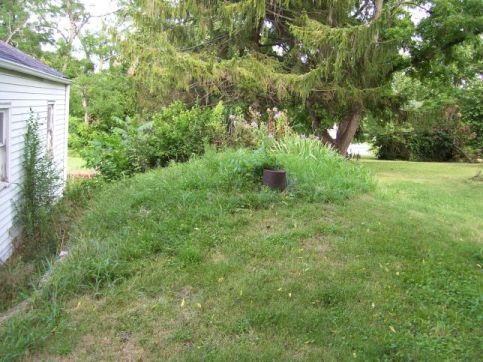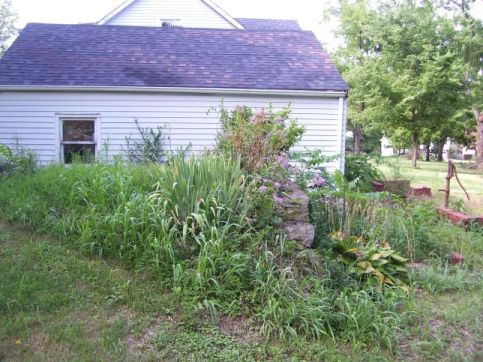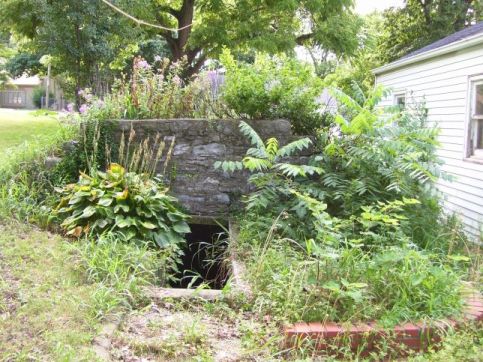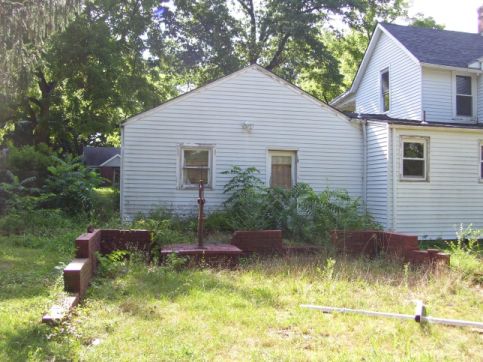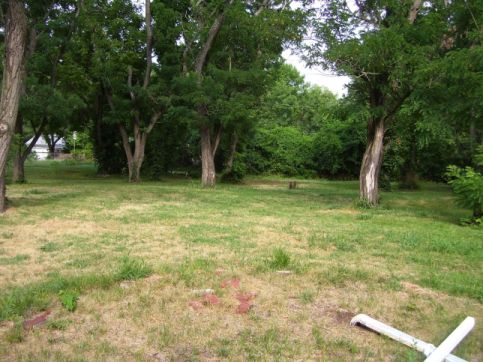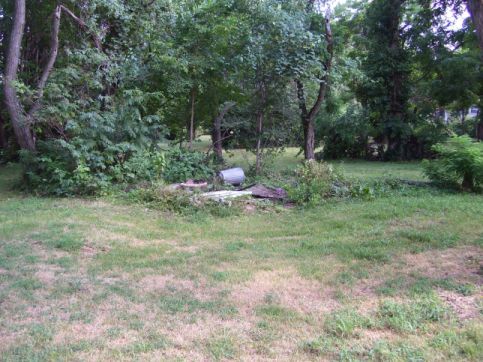
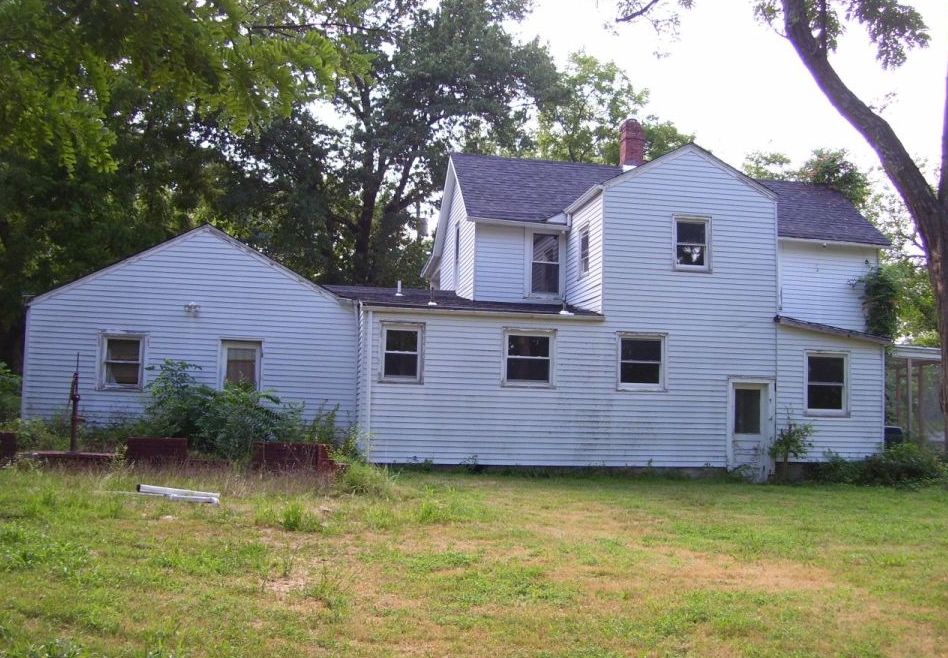
This story also appears in the
October 2012 issue of
Western Eastern Treasures magazine
titled 'The Iron Farm'
Intro
Located in a suburb of Kansas City, MO lies a small community of Raytown. It is bordered by Independence, Lees Summit and Kansas City. A farm house that was built before the Civil War stands out like a sore thumb against the 1950’s homes surrounding the majestic 2-storied, 4 collumned structure with 2 additions added over the years. This peaceful structure lies right on the Santa Fe Trail.
This is the location and the brief story of the L.M. “Squire” Dehoney farm I was able to detect with my good friend Michael Cloe in April-June 2009 when we unearthed an entire life story of 19th Century artifacts. What is even more astonishing is the fact that this piece of property is located only ½ mile from the home of the late Bob Tathum, a legend in the detecting and recovery field in the Kansas City area. How this property remained unhunted until the 2 of us lucked into it is a mystery.
A Brief History
“Squire” Dehoney moved here from Kentucky in 1853 with his wife Sarah Chism Dehoney and built a makeshift house to live in while constructing the main house which would not be ready until 1857. Sarah is, in fact, the niece of John Chism, founder of the famous Chism trail. Her father, Howard Chism, was then known as one of the wealthiest men in the county. Once the main house was ready, they must have made the original structure the outbuilding for storage and/or workplace because this is where we found most of our artifacts in roughly about a 50’x100’ area showing heavy fire signs.
The Legend
During the Civil War the Dehoneys, being Southern sympathizers, came under the threat of Ordinance 11. According to the proprietor of the Raytown Historical Society, this Ordinance instructed Commanders of Union troops the power to burn to the ground and raze any property and/or livestock under the ownership of Southern support. This property was only one of 2 left standing in the Township of Raytown as of 1865. As legend tells, a company of Union troops made the Dehoney farm a stopover point to camp and refresh their animals from the nearby spring. The commander of the troops informed “Squire” that due to the fact he saw signs of Southern loyalty, he would be forced to burn his house and take all the livestock. Mr. Dehoney said “Well, O.K, if you have to, but first let me send you on your way with a full belly.” After the troops were well fed and moistened, the commander told the “Squire” that “He just wasn’t in the mood to burn anyone out of their house today, so you may hang on to it for now.” So, it is 150+ years after the fact of a full belly and satisfied troops that my friend and I were able to obtain permission to hunt this property.
The Cellar
When Michael and I started detecting this property, we had no idea as to the history of this place. However, we were informed by the owner that years ago 2 people started detecting this place, but didn't spend much time there. So we started working systematically from the street (main house view top photo) to the right around the cellar (Fig. 1) to the back yard. We found virtually nothing in the front yard and no modern coins at all . This, we thought, was from the other detectors that had been here before. Our hopes were failing. When we got to the side of the cellar (Fig. 2), we started picking up older items, but nothing from the period as yet. We started finding aluminum tax tokens, and a a few wheat cents. This was in April and the ground was still partly frozen, so we had gotten a late start on the day and by this time had to wrap up our first day. I was unable to make the next hunt, so Michael went alone and filled me in on what happened later by phone. As he made his way around the cellar to the back of the house where the well was located (Fig. 3), he had started picking up more wheaties, an 1893 Indian Cent and a couple Mercury dimes. O.K, we thought. It's getting more interesting as it progresses. The next meeting there we both made it and started at the well where he had left off previously and started working our way into the back yard. That is when we hit “The Patch”.
"The Patch" and "The Find"
About 20’ behind the well and to the right of the cellar (Fig. 4), this area (Fig. 5) looking at The Patch from the well started teasing us for a bit with every kind of iron farm implement you can think of, including countless dozens of brush hog blades . Shortly after that, within the hour or so we started recovering artifacts of 19th Century life (see list below). That's when it hit us. The gentlemen who were here before us must have started pulling iron of all sorts and got frustrated and quit before finding the goods. In an area approximately 50’x100’ (Fig. 5&6) looking from the well out into The Patch and right towards the property line) we spent the majority of every Saturday and Sunday for about 3 months hunting The Patch with a few afternoons thrown in when we could play hooky from work. Then one Sunday we were scheduled to attend our detector club meeting that evening for the Midwestern Artifact Society. We were going to hunt for a few hours before going to our club meeting when I was informed that Michael couldn't make the hunt. So, I decided to go there by myself and just "kill some time" before meeting him to go to our club meeting later. After about 3 hours of digging countless iron items and nothing special to show for it, I looked at the time and noticed I had about a half hour before I needed to head to his house. I was not having that good of a day find-wise and was actually pretty frustrated. That's when I got a half dollar signal at about 6". Brush hog blades ring up like large coins on my MXT and I had dug many, many blades to this point. I figured "Here we go again. I'll dig this one and be on my way." To my surprise, out popped a buckle with an eagle on it. It was too caked with dirt to see clearly, so being tired and finding at least something special, I put the buckle in my bag and headed on over to Michael's house. I had never seen a military buckle before, so I didn't know what I had. Even before we cleaned it off, Michael's eyes widened and he stated "THIS is the stuff we are looking for!" After washing it off, we discovered I had recovered an 1851 Regulation Union Sword Belt Plate (buckle) with a benchmark #19 and had been field repaired. It is my personal best find ever to date.
The puzzle comes together
We filled 2 20-gallon tote tubs full of iron that was just junk, and this was after going over the same area multiple times. But, among that junk were some wonderful items. Every day we worked this property another piece of the puzzle came together with items being turned up. Now, this was just guessing on our part, but we thought we had come close to telling the entire history of the place when we found the location of the old road gravel, the old well, and the location of “The Patch”. Finally, when the old place stopped giving up relic after relic, we decided to go to the Raytown Historical Society and see if they had any information on the place. They had most of the information at which we had already guessed and we had come very close to piecing together the history of the Dehoney place without exact dates except for some of our dated relics. It was a good feeling to have come so close in our guesswork that we both “grew” in knowledge from that point on.
The greatest treasure of all: Grace!
What a wonderful source of information we had for this property! 90-years young, the spunky, good humored Grace (pictured below) lives next door to the Dehoney farm. She is a distant relative (possibly 2nd cousin) to the Dehoneys, and made immediate friends with Michael and myself from the start. She told us that she lived in the house when she was a child and guided us over what she could remember about the history of the place every time we were there. A little sidebar about Grace: Michael and I had been hunting this property for about 6 weekends in a row and Grace had made it a point to come out and visit with us each time. This particular Saturday, we had been hunting for a couple of hours in The Patch when we decided to take a break. At this time we had noticed Grace had not made her daily appearance yet. As we sat on the bricks to the well, 4 Raytown policemen converged on us, two each from both ends of the house. Someone had called the law! As we were proving who we were and showing the policemen our finds, we heard a commotion out front. We turned and looked out front and Grace had come out on her walker and was shaking her finger in a policeman's face and giving them what fer'. "These boys haven't harmed a thing here!" she shouted as loud as her fragile lungs could holler. "These are 2 of the nicest young men I have ever met, and this is a 'load of hooey'!" Long story short, the owner was contacted and the cops let us resume our day after we schooled one of them in the art of getting started in detecting. He was a history nut himself. Grace saved the day!!
The Relics
Some of the relics recovered are not pictured on this site yet. More pics will be added soon. Below is a partial list of what we both recovered at L.M. “Squire” Dehoneys farm.
1851 Regulation Union sword belt plate (buckle). Bench mark #19
Cavalry stirrup
Boss and Acme Patents 1877-1882 Butter Churn counter-weight
H.H. Palmer & Co Rockford Ill.
1893 Indian Head cent, 2 Mercury dimes and wheat cents
Circa 1830-1850’s porcelain marble (See below. Found in the same hole with the Calvary stirrup)
American Flask & Cap Co. powder flask cap
Multiple 19th century lantern wick advance assemblies
Asbestos Sad Iron
Harness rosette
Plow clevis
. Multiple old knife blades
. Possible mortar and pestal pieces
1 double sided axe blade (See below red circle/arrow. I broke this piece in two moving it. Shame!)
Assorted hatchet heads
2 WWII military coat buttons
2 20-gal tote tubs full of tack, wagon parts, brush hog blades, everything iron you can think of.
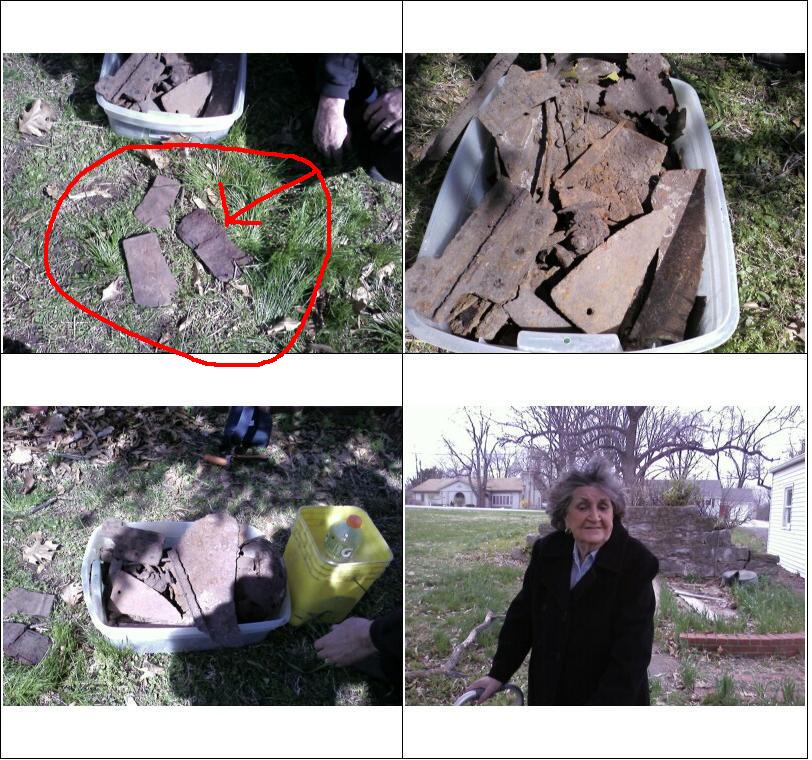
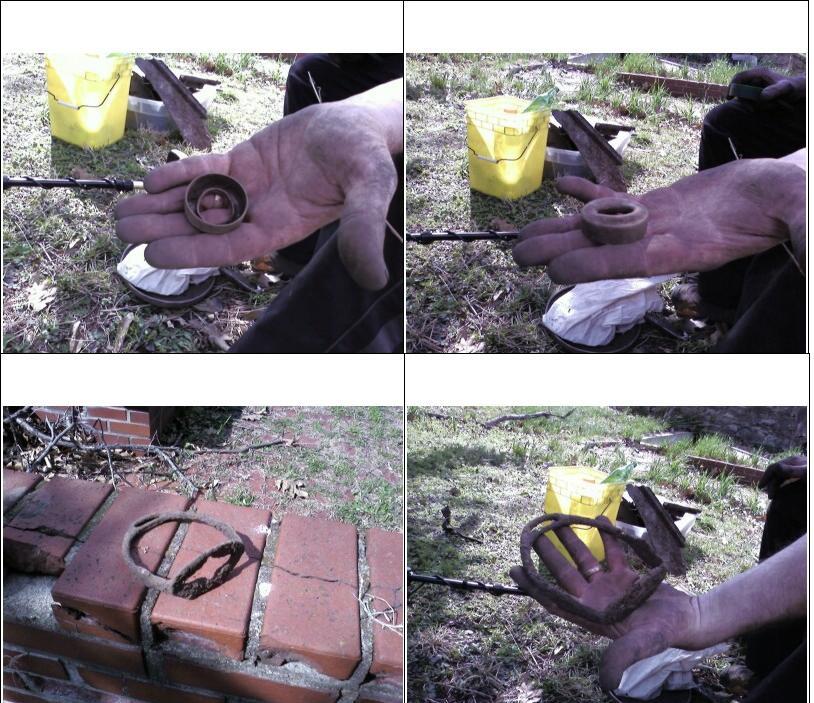

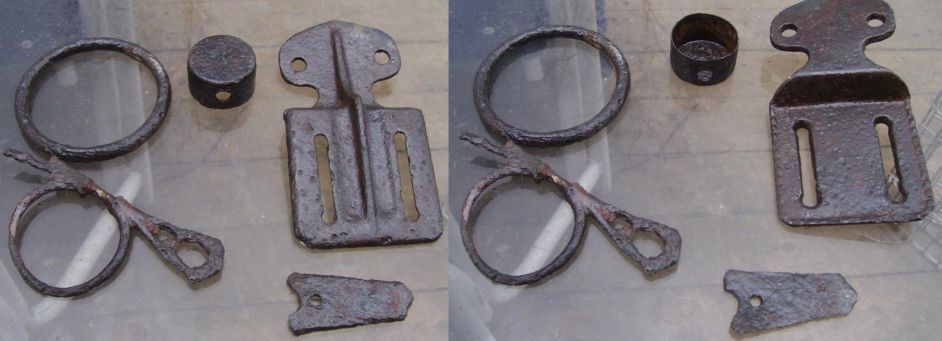
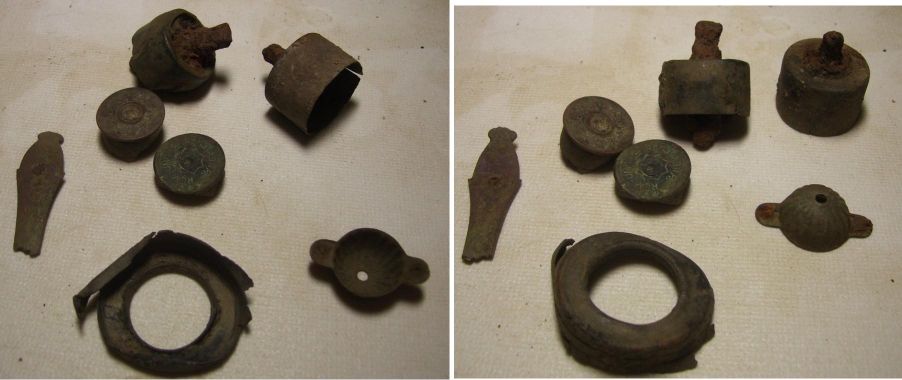

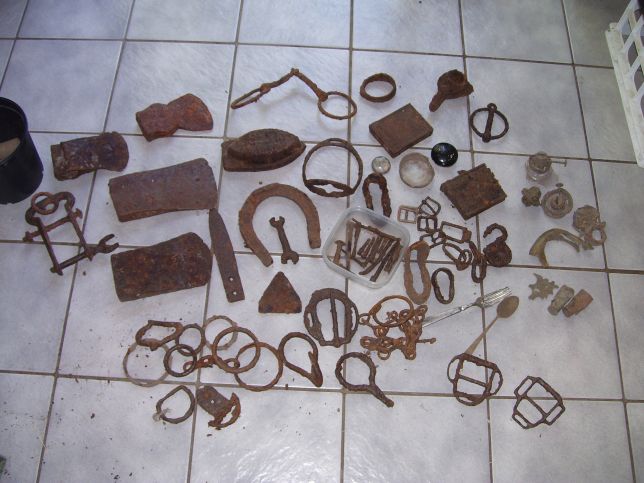
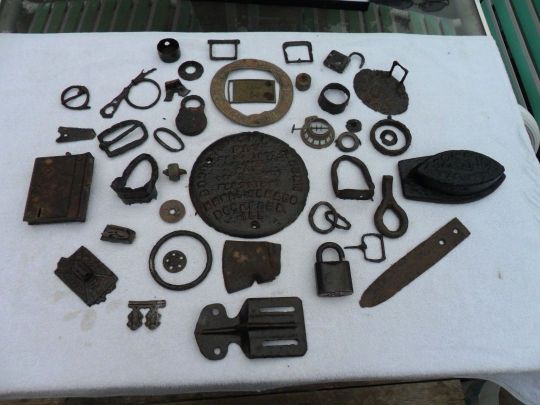
HOME




